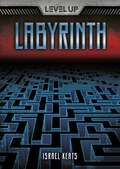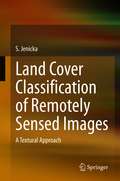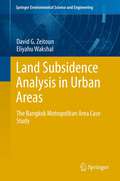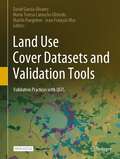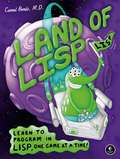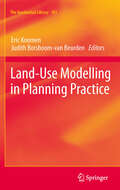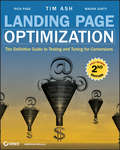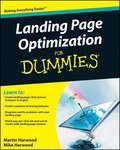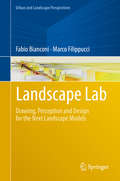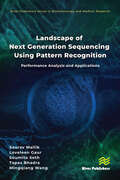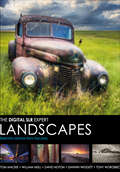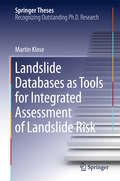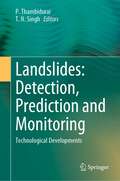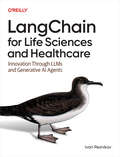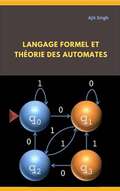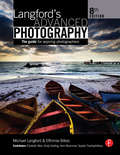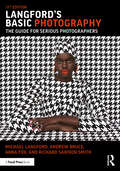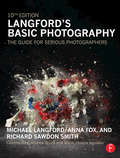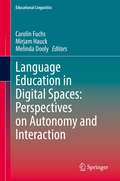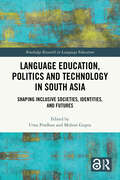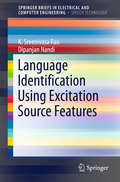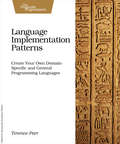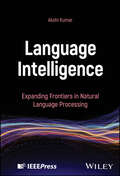- Table View
- List View
Labyrinth (Level Up)
by Israel KeatsSuprSolvr has the opportunity to test a game set in a mechanical labyrinth by playing inside of it, which she's thrilled about. The guy she's partnered with? Not so much. But as they soon face robotic bugs, word puzzles, and obstacles, they realize that they must work together to reach the center of the labyrinth or risk being trapped in virtual reality forever.
Land Acquisition, Industrialization and Livelihoods: A case study on JSW Bengal Steel Plant
by Ramkrishna Maiti Sumanta Prakash SheeThis book provides an assessment of the impacts of human intervention on the natural environment and peoples' livelihoods through land-use conversion due to industrialization. Problems of land acquisition and the execution thereof have varying consequences that depend on the specific geographical as well as socio-political contexts in which they occur. This book covers a specific study of JSW Bengal Steel Ltd., which in 2014 planned to set up a 10.0 million ton per year integrated steel plant at the upper catchment of Sundra basin, the tributary of the Shilabati that ultimately pours to the river Rupnarayan, located at Salboni Block of Paschim Medinipur, West Bengal, India. The project was ultimately put on hold, but caused many lingering environmental and socioeconomic problems due to the acquisition of formerly productive lands. The book examines this case to generate a database on the different aspects of land acquisition and its negative impacts on the geomorphology and hydrological of non-timber forest products, agricultural impacts resulting in livelihood changes, policy dimensions of land acquisition, and the impacts of delays in project implementation through a comparative analysis between projects-affected areas and non-project areas. The book will appeal to environmental managers and industry workers, as well as students and researchers in environmental economics, anthropology, and human geography.
Land Cover Classification of Remotely Sensed Images: A Textural Approach
by S. JenickaThe book introduces two domains namely Remote Sensing and Digital Image Processing. It discusses remote sensing, texture, classifiers, and procedures for performing the texture-based segmentation and land cover classification. The first chapter discusses the important terminologies in remote sensing, basics of land cover classification, types of remotely sensed images and their characteristics. The second chapter introduces the texture and a detailed literature survey citing papers related to texture analysis and image processing. The third chapter describes basic texture models for gray level images and multivariate texture models for color or remotely sensed images with relevant Matlab source codes. The fourth chapter focuses on texture-based classification and texture-based segmentation. The Matlab source codes for performing supervised texture based segmentation using basic texture models and minimum distance classifier are listed. The fifth chapter describes supervised and unsupervised classifiers. The experimental results obtained using a basic texture model (Uniform Local Binary Pattern) with the classifiers described earlier are discussed through the relevant Matlab source codes. The sixth chapter describes land cover classification procedure using multivariate (statistical and spectral) texture models and minimum distance classifier with Matlab source codes. A few performance metrics are also explained. The seventh chapter explains how texture based segmentation and land cover classification are performed using the hidden Markov model with relevant Matlab source codes. The eighth chapter gives an overview of spatial data analysis and other existing land cover classification methods. The ninth chapter addresses the research issues and challenges associated with land cover classification using textural approaches. This book is useful for undergraduates in Computer Science and Civil Engineering and postgraduates who plan to do research or project work in digital image processing. The book can serve as a guide to those who narrow down their research to processing remotely sensed images. It addresses a wide range of texture models and classifiers. The book not only guides but aids the reader in implementing the concepts through the Matlab source codes listed. In short, the book will be a valuable resource for growing academicians to gain expertise in their area of specialization and students who aim at gaining in-depth knowledge through practical implementations. The exercises given under texture based segmentation (excluding land cover classification exercises) can serve as lab exercises for the undergraduate students who learn texture based image processing.
Land Subsidence Analysis in Urban Areas
by David G. Zeitoun Eliyahu WakshalCities built on unconsolidated sediments consisting of clays, silt, peat, and sand, are particularly susceptible to subsidence. Such regions are common in delta areas, where rivers empty into the oceans, along flood plains adjacent to rivers, and in coastal marsh lands. Building cities in such areas aggravates the problem for several reasons: 1. Construction of buildings and streets adds weight to the region causing additional soil deformations. 2. Often the regions have to be drained in order to be occupied. This results in lowering of the water table and leads to hydro-compaction. 3. Often the groundwater is used as a source of water for both human consumption and industrial use. 4. Levees and dams are often built to prevent or control flooding. Earth fissures caused by ground failure in areas of uneven or differential compaction have damaged buildings, roads and highways, railroads, flood-control structures and sewer lines. As emphasized by Barends , "in order to develop a legal framework to claims and litigation, it is essential that direct and indirect causes of land subsidence effects can be quantified with sufficient accuracy from a technical and scientific point of view." Most existing methods and software applications treat the subsidence problem by analyzing one of the causes. This is due to the fact that the causes appear at different spatial scales. For example, over-pumping creates large scale subsidence, while building loading creates local subsidence/consolidation only. Then, maximum permissible land subsidence (or consolidation) is a constraint in different management problems such as: groundwater management, planning of town and/or laws on building construction. It is, therefore, necessary to quantify the contribution of each cause to soil subsidence of the ground surface in cities urban area. In this text book, we present an engineering approach based on the Biot system of equations to predict the soil settlement due to subsidence, resulting from different causes. Also we present a case study of The Bangkok Metropolitan Area (BMA).
Land Use Cover Datasets and Validation Tools: Validation Practices with QGIS
by María Teresa Camacho Olmedo Martin Paegelow David García-Álvarez Jean François MasThis open access book represents a comprehensive review of available land-use cover data and techniques to validate and analyze this type of spatial information. The book provides the basic theory needed to understand the progress of LUCC mapping/modeling validation practice. It makes accessible to any interested user most of the research community's methods and techniques to validate LUC maps and models. Besides, this book is enriched with practical exercises to be applied with QGIS. The book includes a description of relevant global and supra-national LUC datasets currently available. Finally, the book provides the user with all the information required to manage and download these datasets.
Land of Lisp: Learn to Program in Lisp, One Game at a Time! (No Starch Press Ser.)
by Conrad Barski<P>Lisp has been hailed as the world’s most powerful programming language, but its cryptic syntax and academic reputation can be enough to scare off even experienced programmers. Those dark days are finally over—Land of Lisp brings the power of functional programming to the people! <P>With his brilliantly quirky comics and out-of-this-world games, longtime Lisper Conrad Barski teaches you the mysteries of Common Lisp. You’ll start with the basics, like list manipulation, I/O, and recursion, then move on to more complex topics like macros, higher order programming, and domain-specific languages. Then, when your brain overheats, you can kick back with an action-packed comic book interlude! <P>Along the way you’ll create (and play) games like Wizard Adventure, a text adventure with a whiskey-soaked twist, and Grand Theft Wumpus, the most violent version of Hunt the Wumpus the world has ever seen. <P>You'll learn to: <br>–Master the quirks of Lisp’s syntax and semantics <br>–Write concise and elegant functional programs <br>–Use macros, create domain-specific languages, and learn other advanced Lisp techniques <br>–Create your own web server, and use it to play browser-based games <br>–Put your Lisp skills to the test by writing brain-melting games like Dice of Doom and Orc BattleWith Land of Lisp, the power of functional programming is yours to wield.
Land-Use Modelling in Planning Practice
by Eric Koomen Judith Borsboom-van BeurdenThis book provides an overview of recent developments and applications of the Land Use Scanner model, which has been used in spatial planning for well over a decade. Internationally recognized as among the best of its kind, this versatile model can be applied at a national level for trend extrapolation, scenario studies and optimization, yet can also be employed in a smaller-scale regional context, as demonstrated by the assortment of regional case studies included in the book. Alongside these practical examples from the Netherlands, readers will find discussion of more theoretical aspects of land-use models as well as an assessment of various studies that aim to develop the Land-Use Scanner model further. Spanning the divide between the abstractions of land-use modelling and the imperatives of policy making, this is a cutting-edge account of the way in which the Land-Use Scanner approach is able to interrogate a spectrum of issues that range from climate change to transportation efficiency. Aimed at planners, researchers and policy makers who need to stay abreast of the latest advances in land-use modelling techniques in the context of planning practice, the book guides the reader through the applications supported by current instrumentation. It affords the opportunity for a wide readership to benefit from the extensive and acknowledged expertise of Dutch planners, who have originated a host of much-used models.
Landing Page Optimization
by Tim Ash Rich Page Maura GintyA fully updated guide to making your landing pages profitable Effective Internet marketing requires that you test and optimize your landing pages to maximize exposure and conversion rate. This second edition of a bestselling guide to landing page optimization includes case studies with before-and-after results as well as new information on web site usability. It covers how to prepare all types of content for testing, how to interpret results, recognize the seven common design mistakes, and much more. Included is a gift card for Google AdWords. Features fully updated information and case studies on landing page optimization Shows how to use Google's Website Optimizer tool, what to test and how to prepare your site for testing, the pros and cons of different test strategies, how to interpret results, and common site design mistakes Provides a step-by-step implementation plan and advice on getting support and resources Landing Page Optimization, Second Edition is a comprehensive guide to increasing conversions and improving profits.
Landing Page Optimization For Dummies
by Martin Harwood Mike HarwoodTurn landing pages into profits with the right tools Successful landing pages don't happen by accident, they follow a carefully crafted formula. If you want to convert visitors to your site into sales, it's crucial to understand how to design, monitor, and maintain your landing page. This straightforward, plain-English guide shows you how to cover all the bases-from the visual layout, to using language effectively, to linking strategies, and more. The book is packed with practical tips and techniques, it also identifies common mistakes and pitfalls you should avoid. The book features a valuable $50 coupon off the price of a site diagnosis and webinars on the author's website. Discover the power of language and how to use it as a call to action Start predicting customer browsing behavior Diagnose current problems with your landing page Create a unified marketing message between the search engine result and landing page Examine common optimization approaches Master specific tools for tracking results and follow strict maintenance procedures If you want to make your landing page more appealing, this book provides clear, hands-on explanations and information that you can put to use immediately.
Landscape Lab: Drawing, Perception and Design for the Next Landscape Models (Urban and Landscape Perspectives #20)
by Fabio Bianconi Marco FilippucciThis book explores the relationship between the sciences of representation and the strategy of landscape valorisation. The topic is connected to the theme of the image of the city, which is extended to the territory scale and applied to case studies in Italy’s Umbria region, where the goal is to strike a dynamic balance between cultural heritage and nature. The studies demonstrate how landscape represents an interpretive process of finding meaning, a product of the relationships between mankind and the places in which it lives. The work proceeds from the assumption that it is possible to describe these connections between environment, territory and landscape by applying the Vitruvian triad, composed of Firmitas (solidity), Utilitas (utility) and Venustas(beauty). The environment, the sum of the conditions that influence all life, represents the place’s solidity, because it guarantees its survival. In turn, territory is connected to utility, and through its etymological meaning is linked to possession, to a domain; while landscape, as an “area perceived by people”, expresses the search for beauty in a given place, the process of critically interpreting a vision.
Landscape of Next Generation Sequencing Using Pattern Recognition: Performance Analysis and Applications (River Publishers Series in Biotechnology and Medical Research)
by Loveleen Gaur Mingqiang Wang Saurav Mallik Soumita Seth Tapas BhadraThis book focuses on an eminent technology called next generation sequencing (NGS) which has entirely changed the procedure of examining organisms and will have a great impact on biomedical research and disease diagnosis. Numerous computational challenges have been brought on by the rapid advancement of large-scale next-generation sequencing (NGS) technologies and their application. The term ""biomedical imaging"" refers to the use of a variety of imaging techniques (such as X-rays, CT scans, MRIs, ultrasounds, etc.) to get images of the interior organs of a human being for potential diagnostic, treatment planning, follow-up, and surgical purposes. In these circumstances, deep learning, a new learning method that uses multi-layered artificial neural networks (ANNs) for unsupervised, supervised, and semi-supervised learning, has attracted a lot of interest for applications to NGS and imaging, even when both of these data are used for the same group of patients.The three main research phenomena in biomedical research are disease classification, feature dimension reduction, and heterogeneity. AI approaches are used by clinical researchers to efficiently analyse extremely complicated biomedical datasets (e.g., multi-omic datasets. With the use of NGS data and biomedical imaging of various human organs, researchers may predict diseases using a variety of deep learning models. Unparalleled prospects to improve the work of radiologists, clinicians, and biomedical researchers, speed up disease detection and diagnosis, reduce treatment costs, and improve public health are presented by using deep learning models in disease prediction using NGS and biomedical imaging. This book influences a variety of critical disease data and medical images.
Landscapes: Expert advice from top pros (The Digital SLR Expert)
by David Noton Tom Mackie William Neill Darwin Wiggett Tony WorobiecHEADLINE: Build and Refine Your In-Camera and Photoshop Skills with This Authoritative and Visually Stunning Guide to Capturing Incredible Landscape Photographs Practical demonstrations, step-by-step examples and invaluable secrets from five leading professional photographers show you how to use your digital SLR to its full potential Darwin Wiggett, David Noton, William Neill, Tom Mackie and Tony Worobiec tackle subjects key to taking great landscape images: controlling exposure; understanding light; composing shots; choosing the perfect location and working in black and white Breathtaking photography showcases a wide variety of landscape locations from coasts to mountains, cities to countryside and deserts to forests, highlighting the versatility and full potential of digital photography
Landslide Databases as Tools for Integrated Assessment of Landslide Risk
by Martin KloseThis doctoral thesis presents a novel approach to landslide risk assessment that explores the various dimensions of landslide risk in an integrated perspective. The research approach introduced here is tailored for use with landslide databases and Geographic Information Systems (GIS). A landslide susceptibility model is at the heart of this new approach, enabling to identify and delineate areas at risk of landslides and to assess infrastructure exposure. Landslide risk is a pressing societal issue that is still poorly understood. Temporal landslide hazard is derived from landslide frequency statistics and a hydrological simulation approach to estimate triggering thresholds. These methods are integrated into a powerful toolset for cost modeling that uses historical data to compile, model, and extrapolate damage costs on different spatial scales over time. The combination of this toolset with techniques to analyze fiscal cost impacts supports integrated risk assessment by quantifying the economic relevance of landslide losses.
Landslides: Technological Developments
by T. N. Singh P. ThambiduraiThis book intends to decipher the knowledge in the advancement of understanding, detecting, predicting, and monitoring landslides. The number of massive landslides and the damages they cause has increased across the globe in recent times. It is one of the most devastating natural hazards that cause widespread damage to habitat on a local, regional, and global scale. International experts provide their experience in landslide research and practice to help stakeholders mitigate and predict potential landslides. The book comprises chapters on: Dynamics, mechanisms, and processes of landslides; Geological, geotechnical, hydrological, and geophysical modelling for landslides; Mapping and assessment of hazard, vulnerability, and risk associated with landslides; Monitoring and early warning of landslides; Application of remote sensing and GIS techniques in monitoring and assessment of landslides. The book will be of interest to researchers, practitioners, and decision-makers in adapting suitable modern techniques for landslide study.
Lane-Based Unmanned Aircraft Systems Traffic Management (Unmanned System Technologies)
by Thomas C. Henderson David SacharnyThe age of Advanced Air Mobility (AAM) is upon us, and in ushering new ways to connect and travel, this wave of technology has been compared to GPS and cloud computing. However, new technologies like AAM require tools to build, expand, and understand the capabilities. This book describes an effective and efficient, complete solution to the large-scale, unmanned aircraft systems (UAS) traffic management problem. The authors present a detailed perspective and solutions to some of the major problems involved in coordinating thousands of autonomous vehicles including: virtual highway (lane) creation, strategic deconfliction of flights, dynamic deconfliction, UAS agent behavior learning, anomalous trajectory detection and classification, as well as a set of simulation results for a variety of scenarios (city package delivery, earthquake supply delivery, coalition force coordination through the lane reservation system, etc.).
LangChain for Life Sciences and Healthcare: Innovation Through LLMs and Generative AI Agents
by Ivan ReznikovFeeling overwhelmed by the volume of data in your research? Sifting through massive amounts of data to find useful insights is becoming increasingly difficult in drug discovery, genetics, and healthcare. Enter the era of generative AI with LangChain, whose groundbreaking tools are changing the way life scientists and researchers operate. In this groundbreaking book, Dr. Ivan Reznikov teaches you to harness the power of AI to elevate your research capabilities. Divided into two parts, the first is essential for any specialist, covering the transition from traditional statistics to generative AI, the fundamentals of large language models, and the practical uses of LangChain. The second part is designed for life science professionals who want to create AI applications for biology, chemistry, drug development, and more. By the end, you will: Learn how to easily create and integrate LangChain applications into research Discover how to substantially accelerate your experimental and data analysis operations Explore cutting-edge AI solutions designed to address complex research problems Gain the skills and knowledge to advance your career in AI-enhanced life sciences
Langage Formel ET Théorie des Automates
by Ajit SinghLe livre contient une couverture approfondie de tous les sujets liés à la théorie du calcul tels que mentionnés dans les programmes de B.E., M.C.A. et M.Sc. (Informatique) de diverses universités. Une quantité suffisante d'apports théoriques soutenus par un certain nombre d'illustrations sont incluses pour ceux qui s'intéressent profondément au sujet. Dans les premiers chapitres, le livre présente le matériel de base nécessaire à l'étude des théories des automates. Exemples de sujets inclus : langages réguliers et théorème de Kleene ; automates minimaux et monoïdes syntaxiques ; la relation entre les langages sans contexte et les automates à pile ; et les machines de Turing et la décidabilité. Ce livre facilite aux étudiants un style d'écriture plus informel tout en offrant la couverture la plus accessible de la théorie des automates, un traitement solide sur la construction de preuves, de nombreuses figures et diagrammes pour aider à transmettre des idées et des encadrés pour mettre en évidence le matériel connexe. Chaque chapitre offre une abondance d'exercices pour un apprentissage pratique.
Langford's Advanced Photography: The Guide For Aspiring Photographers (Advanced Photography Ser.)
by Michael Langford Efthimia BilissiLangford's Advanced Photography is the only advanced photography guide a serious student or aspiring professional will ever need. In this eighth edition, Efthimia Bilissi continues in the footsteps of Michael Langford by combining an unrivalled level of technical detail with a straightforward writing style while simultaneously bringing the text firmly in to the digital era.This book covers the entire photographic process from a technical standpoint - not only detailing the 'how' but also explaining the 'why' that is so often missing from photography texts. From the workings of cameras, lenses, digital imaging sensors and software to new hot topics such as HDR imaging, digital asset management, and even running your own photography business, everything a serious photographer could need to extend their art into professional realms is covered.The book also benefits from a full glossary, charts and inspirational full color images throughout, with summaries and projects at the end of each chapter to reinforce the theory.
Langford's Basic Photography: The Guide for Serious Photographers
by Michael Langford Andrew Bruce Anna Fox Richard Sawdon SmithThis seminal photography text, now in its 11th edition, has been revamped, reorganized, and modernized to include the most up-to-date and need-to-know information for photographers. Introducing all the key concepts and fundamentals of photography, this book is a must-have for any photographer’s bookcase.Providing examples and practical information throughout to allow photographers to apply concepts to their own work, the text explains the fundamentals of photography in an accessible way. Fully updated to reflect the dynamic changes in the industry, this 11th edition includes expanded and updated content focusing on advances in camera technology and digital lighting, connecting with the global photography industry and professional networks through social media, updated images throughout, and a new chapter on new digital outputs.Ideal as a foundational text for students of photography as well as a key reference for professionals.
Langford's Basic Photography: The Guide for Serious Photographers
by Richard Sawdon Smith Anna FoxThis seminal photography text, now in its 10th edition and celebrating its 50th anniversary, has been revamped, reorganized, and modernized to include the most up-to-date, need to know information for photographers. Ideal for students, beginners, and advanced users wanting to brush up on the fundamentals of photography, this book is a must have for any photographer’s bookcase. The heart of this text, however, retains the same comprehensive mix of scholarly and practical information. The new edition has been fully updated to reflect dynamic changes in the industry. These changes include: an expansion and overhaul of the information on digital cameras and digital printing; an emphasis on updating photographs to include a wider range of international work; replacement of many diagrams with photos; overhaul of the analogue sections to give a more modern tone (ie exposure measurement and film and filters with some more dynamic photo illustrations).
Language Education in Digital Spaces: Perspectives on Autonomy and Interaction (Educational Linguistics #52)
by Carolin Fuchs Mirjam Hauck Melinda DoolyThis book brings together contributions on learner autonomy from a myriad of contexts to advance our understanding of what autonomous language learning looks like with digital tools, and how this understanding is shaped by and can shape different socio-institutional, curricular, and instructional support. To this end, the individual contributions in the book highlight practice-oriented, empirically-based research on technology-mediated learner autonomy and its pedagogical implications. They address how technology can support learner autonomy as process by leveraging the affordances available in social media, virtual exchange, self-access, or learning in the wild (Hutchins, 1995). The rapid evolution and adoption of technology in all aspects of our lives has pushed issues related to learner and teacher autonomy centre stage in the language education landscape. This book tackles emergent challenges from different perspectives and diverse learning ecologies with a focus on social and educational (in)equality. Specifically, to this effect, the chapters consider digital affordances of virtual exchange, gaming, and apps in technology-mediated language learning and teaching ranging from instructed and semi-instructed to self-instructed contexts. The volume foregrounds the concepts of critical digital literacy and social justice in relation to language learner and teacher autonomy and illustrates how this approach may contribute to institutional objectives for equality, diversity and inclusion in higher education around the world and will be useful for researchers and teachers alike.
Language Education, Politics and Technology in South Asia: Shaping Inclusive Societies, Identities, and Futures (Routledge Research in Language Education)
by Uma Pradhan Mohini GuptaBringing together research from the fields of linguistics, education and technology within the dynamic context of South Asia, this timely book investigates the ways in which these fields interact with each other against the backdrop of technological innovation, linguistic diversity and socio-political transformation.Developing and expanding on findings and insights originating from a conference organised by the Education South Asia Initiative at the University of Oxford, this interdisciplinary book features academic reflections on language politics and diversity as well as empirical insights on linguistic, educational and technological transformations in the region. Featuring analytical and methodological approaches to the study of language and education, chapters range in context from India, Bangladesh, Nepal, Pakistan and Sri Lanka, and address a range of issues such as the marginalisation of languages in education and policy, the interactions between language and social hierarchies in the South Asian context, and technology’s impact on language education, acquisition, usage and preservation.Ultimately initiating dialogue on the need for positive changes in language, education research and policy, this book will appeal to scholars, researchers and postgraduate students in the fields of language education, international and comparative education, and education and technology. Policymakers in international development and sociolinguistics may also find the volume of use.The Open Access version of this book, available at http://www.taylorfrancis.com, has been made available under a Creative Commons Attribution-Non Commercial-No Derivatives (CC BY-NC-ND) 4.0 license.
Language Identification Using Excitation Source Features
by K. Sreenivasa Rao Dipanjan NandiThis book discusses the contribution of excitation source information in discriminating language. The authors focus on the excitation source component of speech for enhancement of language identification (LID) performance. Language specific features are extracted using two different modes: (i) Implicit processing of linear prediction (LP) residual and (ii) Explicit parameterization of linear prediction residual. The book discusses how in implicit processing approach, excitation source features are derived from LP residual, Hilbert envelope (magnitude) of LP residual and Phase of LP residual; and in explicit parameterization approach, LP residual signal is processed in spectral domain to extract the relevant language specific features. The authors further extract source features from these modes, which are combined for enhancing the performance of LID systems. The proposed excitation source features are also investigated for LID in background noisy environments. Each chapter of this book provides the motivation for exploring the specific feature for LID task, and subsequently discuss the methods to extract those features and finally suggest appropriate models to capture the language specific knowledge from the proposed features. Finally, the book discuss about various combinations of spectral and source features, and the desired models to enhance the performance of LID systems.
Language Implementation Patterns: Create Your Own Domain-Specific and General Programming Languages
by Terence ParrLearn to build configuration file readers, data readers, model-driven code generators, source-to-source translators, source analyzers, and interpreters. You don't need a background in computer science--ANTLR creator Terence Parr demystifies language implementation by breaking it down into the most common design patterns. Pattern by pattern, you'll learn the key skills you need to implement your own computer languages.Knowing how to create domain-specific languages (DSLs) can give you a huge productivity boost. Instead of writing code in a general-purpose programming language, you can first build a custom language tailored to make you efficient in a particular domain.The key is understanding the common patterns found across language implementations. Language Design Patterns identifies and condenses the most common design patterns, providing sample implementations of each.The pattern implementations use Java, but the patterns themselves are completely general. Some of the implementations use the well-known ANTLR parser generator, so readers will find this book an excellent source of ANTLR examples as well. But this book will benefit anyone interested in implementing languages, regardless of their tool of choice. Other language implementation books focus on compilers, which you rarely need in your daily life. Instead, Language Design Patterns shows you patterns you can use for all kinds of language applications.You'll learn to create configuration file readers, data readers, model-driven code generators, source-to-source translators, source analyzers, and interpreters. Each chapter groups related design patterns and, in each pattern, you'll get hands-on experience by building a complete sample implementation. By the time you finish the book, you'll know how to solve most common language implementation problems.
Language Intelligence: Expanding Frontiers in Natural Language Processing
by Akshi KumarThorough review of foundational concepts and advanced techniques in natural language processing (NLP) and its impact across sectors Supported by examples and case studies throughout, Language Intelligence provides an in-depth exploration of the latest advancements in natural language processing (NLP), offering a unique blend of insight on theoretical foundations, practical applications, and future directions in the field. Comprised of 10 chapters, this book provides a thorough understanding of both foundational concepts and advanced techniques, starting with an overview of the historical development of NLP and essential mechanisms of Natural Language Understanding (NLU) and Natural Language Generation (NLG). It delves into the data landscape crucial for NLP, emphasizing ethical considerations, and equips readers with fundamental text processing techniques. The book also discusses linguistic features central to NLP and explores computational and cognitive approaches that enrich the field’s advancement. Practical applications and advanced processing techniques across various sectors like healthcare, legal, finance, and education are showcased, along with a critical examination of NLP metrics and methods for evaluation. The appendices offer detailed explorations of text representation methods, advanced applications, and Python’s NLP capabilities, aiming to inform, inspire, and ignite a passion for NLP in the ever-expanding digital universe. Written by a highly qualified academic with significant research experience in the field, Language Intelligence covers topics including: Fundamental text processing, covering text cleaning, sentence splitting, tokenization, lemmatization and stemming, stop-word removal, part-of-speech tagging, and parsing and syntactic analysisComputational and cognitive approaches, covering human-like reasoning, transfer learning, and learning with minimal examplesAffective, psychological, and content analysis, covering sentiment analysis, emotion recognition, irony, humour, and sarcasm detection, and indicators of distressMultilingual natural language processing, covering translation and transliteration, cross-lingual models and embeddings, low-resource language processing, and cultural nuance and idiom recognition Language Intelligence is an ideal reference for professionals across sectors and graduate students in related programs of study who have a foundational understanding of computer science, linguistics, and artificial intelligence looking to delve deeper into the intricacies of NLP.
